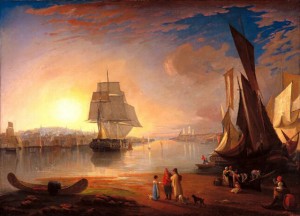10.1 Introduction

(The Port of Halifax, 1830-1840, artist unknown.)
Changing economic conditions contributed to and worked in tandem with changing social relations and experiences. Even in those places in British North America where lives continued along paths that had existed for centuries — in fishing communities, on farms, and among bison hunters — social changes were taking place. Technological innovations arose and a population explosion was underway around the North Atlantic. Some of these changes came so fast that people caught in their midst could not see them. Take William Lyon Mackenzie, for example. In the 1830s he was fighting on the streets of Toronto for greater democratic rights. Mackenzie’s city — a commercial centre typical of British North America’s major towns, if a bit larger than most – was undergoing a messy and complex rebirth. Cities were looking up the hill of a long growth curve that would continue for more than a century and would transform city dwellers into a constituency that Mackenzie would hardly recognize. Just as his political career reached its peak, the oppressed majority he spoke for were in the process of becoming a minority in their own towns.
This new era of urbanization was fed by immigration and rural abandonment and was fired by coal and steam. The ideal member of society, which was held to be the independent landowner and the yeoman farmer, was being overtaken by events and a new society.
This chapter considers some of the major social changes taking place in the middle of the 19th century. This period — the dawn of the age of steam — was also the proving ground for 20th century modernity. Cities, working-class neighbourhoods, labour organizations, gender issues, environmental decay, and public health and welfare were all topics of conversation and concern, especially as the 1860s approached. This chapter offers an introduction to some of the concerns of social historians looking at the 19th century. It also introduces some of the approaches taken in scholarly histories.
Learning Objectives
- Identify the underlying economic and human factors driving social change in the period 1818-1860.
- Describe the main social classes and their relationship to one another.
- Outline the main cities of British North America in the 19th century and why they were growing.
- Sketch the ways in which gender roles and the experiences of children were changing.
Attributions
Figure 10.1
The Port of Halifax (1830 – 1840) by Tetraktys is in the public domain.

